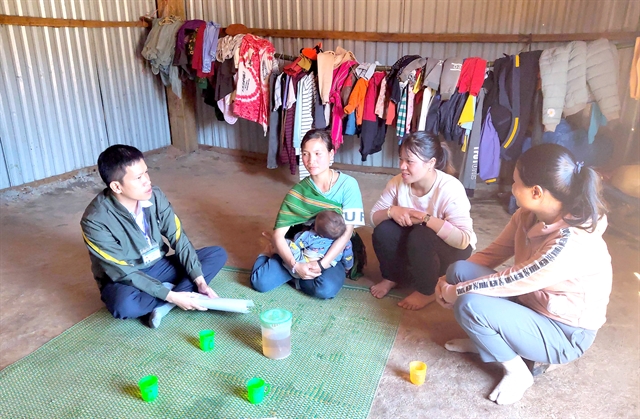.jpg) Society
Society

More than 15 per cent of total families in Kon Tum have reported giving birth to more than three children, making the province lead the Central Highland in third child birthrate, the provincial Health Department has announced.

|
| Health workers disseminate about family planning and reproductive healthcare in Đăk Hà Commune, Tu Mơ Rông District in the Central Highland province of Kon Tum. VNA/VNS Photo Dư Toàn |
KONTUM — More than 15 per cent of total families in Kon Tum have reported giving birth to more than three children, making the province lead the Central Highland in third child birthrate, the provincial Health Department has announced.
Although the figure is lower than last year, the province has failed to meet the goal of reducing the third child birthrate to 15 per cent, it said.
Tu Mơ Rông is among the districts with high birthrates in the province. Figures from the district’s Sub-department of Population and Family Planning showed nearly 15 per cent of total families had more than three children last year. Notably, the percentage was 29.5 per cent in Đăk Hà Commune.
According to Y Khương, head of Ngọc Leang Village in Đăk Hà Commune, more than 110 Xơ Đăng ethnic minority households are in the village, and 108 of them have more than three children. Some even have more than 10 children.
Nearly half of these households live in poverty.
At the age of 22, Y Thum is the mother of three children in Ngọc Leang Village.
Thum said her family lived in a worn-out house built with wood and corrugated iron panels and there was nothing valuable in the house.
She has to stay at home to take care of the children, so they live on her husband's small salary.
In Đăk Rơ Wa Commune in Kon Tum Province, the situation is no better. As many as 115 out of 170 households have more than three children. These include five households, all Bahnar ethnic minorities, that have more than ten children.
Y Khai Hoang is a 33-year-old mother of 11 children. After getting married in 2004, she gave birth to her children between 2004 and 2018.
The family of 13 lives in a small house in Kon Jơ Rin Village. They have no farmland and have to work odd jobs for money.
“My first two children are studying in high school, the next two are in secondary school, the next four are primary students and the two youngest are in kindergarten,” she said.
“I don’t have to pay school fees, but the money for study tools is quite costly so I have no money left to repair the house. It’s getting seriously downgraded.”
When asked how she hoped to get out of the situation, Hoang just shook her head.
The high fertility rate has not only brought poverty but also little chance of education for children and health risks for mothers.
Hồ Thị Thuỳ Vân, principal of Đăk Hà Primary School, said about 100 out of 622 students in the school were from families with more than three children. These students were sometimes absent from class as they had to help their parents with farm work.
Dr Đỗ Ngọc Hoà, deputy director of Kon Tum Province’s Health Department, said getting pregnant again less than 12 months after giving birth was associated with health risks for both women and infants.
This was worse in rural areas where most lived in poverty and had little chance of accessing health care services, she added.
Ineffective policies
The provincial Department of Health said it had implemented many programmes on family planning since 2011, but the results had remained modest.
Yang, a population health officer in Đăk Rơ Wa Commune, said five officers were mobilised to hold training courses on reproductive healthcare for local residents in five villages.
Last year, more than 1,800 residents joined the courses and 854 families received guidelines on reproductive healthcare knowledge. However, the third child birthrate remained 35 per cent last year.
“They joined the courses but didn’t follow the guidelines. Some still take contraception but use it incorrectly with the wrong dose and time. By the end of last year, only half of the couples applied modern contraceptive methods in the commune,” she said.
In Tu Mơ Rông District, the health division has held 43 talk shows with reputable people in the community on reproductive healthcare, distributed 3,300 leaflets and guideline brochures and offered direct consultancy to 220 families. But the district has the highest fertility rate in the province.
Nguyễn Duy Tân, health officer at Tu Mơ Rông District’s Health Centre, said low awareness of local residents, language barriers and low payment for health workers were among the main reasons for the failure to make a difference.
Currently, each health worker receives VNĐ149,000 (US$5.9) per person every three months instead of VNĐ750,000 ($30) as previously for disseminating reproductive healthcare knowledge.
Village leaders are now in charge of population and family planning, but most are not trained to do the job, leading to ineffective programmes and policies.
Dr Hoà, deputy director of the health department, said it was necessary to improve the consultancy capacity of health workers and create dissemination methods for ethnic minorities suitable for their customs and lifestyles. — VNS

.jpg)


